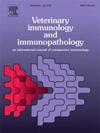猫泛白细胞减少症患者中性粒细胞与淋巴细胞比率和血小板指数的预后价值。
IF 1.4
3区 农林科学
Q4 IMMUNOLOGY
引用次数: 0
摘要
本研究旨在确定猫泛白细胞减少症(FPV)患者入院时中性粒细胞与淋巴细胞比率(NLR)和血小板指数对预后的意义。我们对 24 只确诊为 FPV 的猫咪进行了前瞻性观察研究。研究结果表明,与对照组相比,FPV 幸存者组的 NLR、血小板计数(PLT)和血小板浓度(PCT)显著下降。此外,与对照组和 FPV 幸存者组相比,FPV 非幸存者组的这些参数也明显下降。相反,与对照组相比,未存活的 FPV 猫的平均血小板体积(MPV)和血小板分布宽度(PDW)明显升高。此外,还采用了接收器操作特征曲线(ROC)分析来确定预测FPV猫预后的临界值。使用 NLR(≤ 0.29)、PLT(≤ 202.5 ×10³/µL)、PCT(≤ 0.19 %)、MPV(≥ 10.3 fL)和 PDW(≥ 34.9 %)的临界值,确定了存活率的阳性预测值(PPV)分别为 90 %、95 %、85 %、85 %、85 % 和 75 %。根据 ROC 分析得出的灵敏度、特异性和阳性预测值,可以得出结论:NLR、MPV 和 PLT 是确定 FPV 猫预后的极佳生物标志物。不过,PLT 水平的意义更大,其 AUC 值更高。本文章由计算机程序翻译,如有差异,请以英文原文为准。
Prognostic value of neutrophil to lymphocyte ratio and platelet indices in cats with feline panleukopenia
The aim of this study was to ascertain the prognostic significance of the neutrophil to lymphocyte ratio (NLR) and platelet indices during hospital admission in cats with feline panleukopenia (FPV). A prospective observational study was conducted on 24 cats diagnosed with FPV. The results of the study demonstrated a significant decrease in NLR, platelet count (PLT), and platelet concentration (PCT) in the FPV survivor group compared to the control group. Furthermore, these parameters exhibited a notable decline in the FPV non-survivor group when compared to both the control group and the FPV survivor group. In contrast, mean platelet volume (MPV) and platelet distribution width (PDW) were significantly elevated in the FPV non-surviving cats compared to the control group. Moreover, receiver operating characteristic (ROC) curve analysis was employed to identify a prognostic cut-off value for predicting the prognosis of cats with FPV. The positive predictive values (PPVs) for survival were determined to be 90 %, 95 %, 85 %, 85 %, 85 %, and 75 %, respectively, using cut-off values of NLR (≤ 0.29), PLT (≤ 202.5 ×10³/µL), PCT (≤ 0.19 %), MPV (≥ 10.3 fL), and PDW (≥ 34.9 %). Based on the sensitivity, specificity and positive predictive values obtained from the ROC analysis, it was concluded that the NLR, MPV, and PLT are excellent biomarkers for determining prognosis in cats with FPV. Nevertheless, the PLT level is of greater significance, exhibiting a higher AUC.
求助全文
通过发布文献求助,成功后即可免费获取论文全文。
去求助
来源期刊
CiteScore
3.40
自引率
5.60%
发文量
79
审稿时长
70 days
期刊介绍:
The journal reports basic, comparative and clinical immunology as they pertain to the animal species designated here: livestock, poultry, and fish species that are major food animals and companion animals such as cats, dogs, horses and camels, and wildlife species that act as reservoirs for food, companion or human infectious diseases, or as models for human disease.
Rodent models of infectious diseases that are of importance in the animal species indicated above,when the disease requires a level of containment that is not readily available for larger animal experimentation (ABSL3), will be considered. Papers on rabbits, lizards, guinea pigs, badgers, armadillos, elephants, antelope, and buffalo will be reviewed if the research advances our fundamental understanding of immunology, or if they act as a reservoir of infectious disease for the primary animal species designated above, or for humans. Manuscripts employing other species will be reviewed if justified as fitting into the categories above.
The following topics are appropriate: biology of cells and mechanisms of the immune system, immunochemistry, immunodeficiencies, immunodiagnosis, immunogenetics, immunopathology, immunology of infectious disease and tumors, immunoprophylaxis including vaccine development and delivery, immunological aspects of pregnancy including passive immunity, autoimmuity, neuroimmunology, and transplanatation immunology. Manuscripts that describe new genes and development of tools such as monoclonal antibodies are also of interest when part of a larger biological study. Studies employing extracts or constituents (plant extracts, feed additives or microbiome) must be sufficiently defined to be reproduced in other laboratories and also provide evidence for possible mechanisms and not simply show an effect on the immune system.

 求助内容:
求助内容: 应助结果提醒方式:
应助结果提醒方式:


